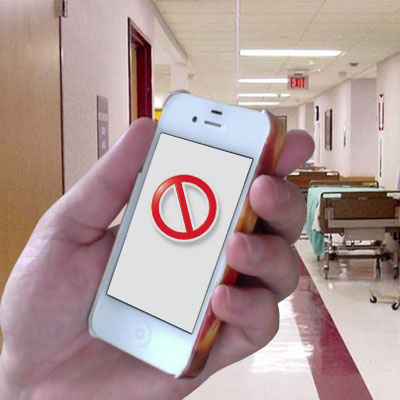Mobile devices have become an ever-present part of our connected culture. With smartphones, tablets, and cell phones expected to outnumber people, in the US, by the end of the year, what can a hospital do to maintain some level of quiet? Allowing cell phone use, while adhering to HIPAA guidelines can also be problematic because it may compromise patient privacy.
Patients need sleep in order to heal, and yet the latest survey data from the Hospital Care Quality Information from the Consumer Perspective (HCAHPS) reveals that noise levels, especially at night, are a problem. The increasing volume can be attributed to equipment in patient rooms, but more often than not, it’s the people. There are discussions between doctors and nurses, physicians assistants and residents, patients and their visitors, all who find the best way to communicate is by using their cellphones. They also want to make and take those calls from wherever they are. However, these are not idle nor unimportant conversations.
Medical staff need to talk with one-another to provide appropriate care. Visitors, family and friends give each other critical updates to and about their loved ones. All this talking on mobile devices adds to the noise level in a health care environment. Clearly, eliminating cell phone use is not going to work. Perhaps there are some ways to satisfy the needs of patient care and keep the noise down.
Of course Acoustics By Design can help healthcare facilities ensure compliance with patient privacy laws through space-planning, and reduce building noise through mechanical and structural sound remediation. Yet, our work doesn’t end there. As an industry leader, not only in the technical specifications to create cell phone zones, we also advise administrators regarding staff and visitor behavior. Some basic restrictions of cell phone usage, in combination with general noise reduction can keep things quiet.
Simple steps like restricting use by time of day, or changing the ring tone over to vibrate are easy to implement and enforce. It’s amazing the difference in noise between a gentle buzz, and that old-school phone ring everyone seems to love. ABD will also recommend the right ceiling tiles, doors, and other materials to help deaden sound and keep it from traveling.
This general reduction carries with it an added bonus! We know that when we’re in quiet surroundings, like a library, we tend to automatically adjust our voices, further improving a peaceful setting. This translates into more quiet for the patients. Choosing to engage an acoustical consulting firm to assist with existing facilities or new construction can create positive change in the HCAHPS scores, and improve patient care.
